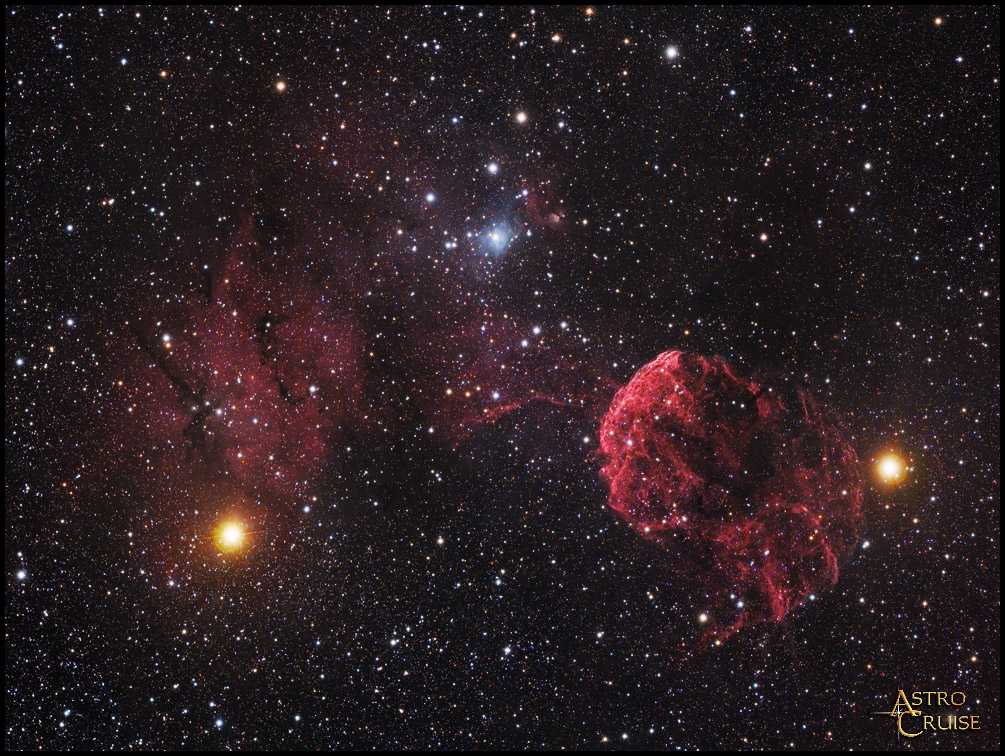There is a big and interesting difference between Sharpless 249 and the Jellyfish Nebula. Sharpless 249 is bland and relatively featureless, but the Jellyfish Nebula looks like the aftermath of a wreck. Or rather, it looks like the shattered remains of an explosion, and that is what it is, too.
Another fascinating coincidence of this part of the sky is that here we see the juxtaposition of red nebulas and orange stars. But orange stars don't make red nebulas - at best, like "red" (really yellow-orange) supergiant Antares, they can make
yellow reflection nebulas.
So what's going on in Gemini? Well, for one thing, the two bright orange stars have nothing to do with the red nebulas. Mu Geminorum, the orange star at left, is an M-type giant less than 300 light-years away, much, much closer than the Jellyfish Nebula and much closer than Sharpless 249, too. Eta Geminorum is another M-type giant that is farther away than Mu, but it is less than 400 light-years away and again much closer than the two red nebulas. So not only do the orange stars have nothing to do with the red nebulas, but they probably have nothing to do with each other, either.
For all of that, it is remarkable that two so bright-looking M-type giants are located so close to one another in the sky, because M-type giants are relatively rare. Mu Gem shines at bright third magnitude and Eta Gem at faint third magnitude, and they completely dominate their own little part of the sky. In the picture at right, Mu and Eta are at bottom center. Mu is located "above" Eta, and it is very red-looking due to the fact that it seems to be attached to Sharpless 249. Eta is at lower right from Mu, looking orange rather than red. The small Jellyfish Nebula can be clearly seen between them. To the lower left of Eta is the small, round, bright pink Monkey Head Nebula. To the right of Eta is bright white cluster M35 (and below M35, faint distant cluster NGC 2158 and boring nearby orange star Propus, or 1 Geminorum).
Fascinatingly, between the Monkey Head Nebula and M35 are at least three intrinsically brilliant M-type supergiants, TV Geminorum, BU Geminorum and WY Geminorum. To get so many M-type supergiants in a small patch of sky you need to start out with a lot of hot massive blue stars and have them age and evolve into red giants. And indeed, there really are several hot, distant and dust-reddened B-type stars in the general vicinity: LU Gem, PX Gem and PU Gem. So this part of the sky is dominated by bright, massive but nevertheless aging young stars, which is why it contains both emission nebulas, bright clusters, hot blue B-type supergiant stars and red M-type supergiants.
But eye-catching Mu and Eta Geminorum are not part of the action, but are just passing by in the foreground in their unusual M-type splendor. Oh, and for those of you who are wondering: The obvious blue reflection nebula in Sharpless 249 is van den Bergh 75, centered on 12 Geminorum, a bright A-type giant probably a couple of thousand light-years away, just like Sharpless 249 and many of the bright distant B-type and M-type supergiants here.
Ann
 Sharpless 249 and the Jellyfish Nebula
Sharpless 249 and the Jellyfish Nebula
